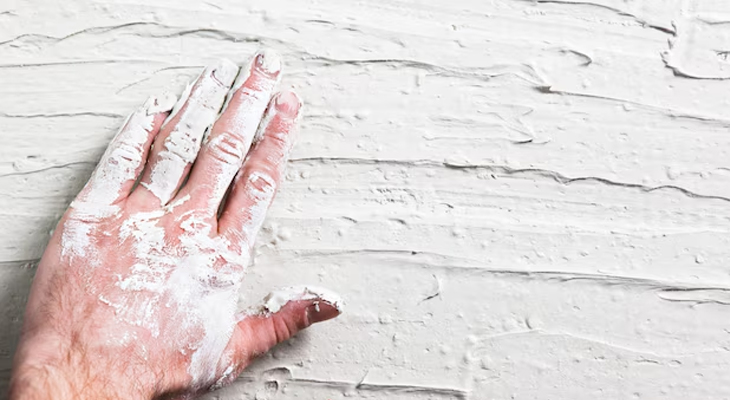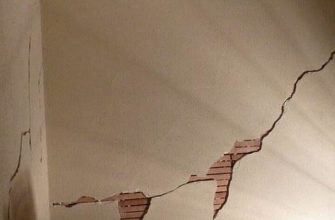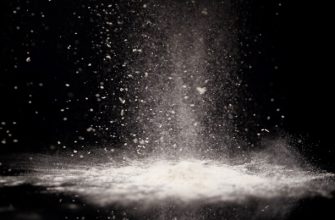We don’t often refer to construction materials or supplies as “mouth-watering” or “yummy-looking.” Yes, we do say “nicely textured,” “artistic,” “productive” or “exciting,” but never “yummy-looking,” “mouth-watering,” etc.
This is because, as adults, our first thought will be that building materials contain poisonous or toxic chemicals and thus aren’t something for eating or drinking.
However, many young children fail to understand the threat these building materials can cause to their health and end up licking, tasting, biting, or consuming these sorts of substances. As a result, these building supplies must be kept away from children at all costs.
Spackle is one such item to keep out of the reach of small children.
Spackle, also known as a spackling compound, joint compound, or drywall mud, is a white, smooth, malleable filler that helps to repair holes in walls or gaps among layers of drywall or wallboard before painting.
It is sold in pre-mixed tubs or squeezable tubes, and during work, it is blended with a solvent to form a paste that can be jammed into the hole. After the applied mixture has dried up, sandpaper is used to smooth it out.
DAP Spackling Paste and DryDex Spackling are two prominent spackle brand items.
Children are frequently attracted to tasting the spackling compounds because of their milky or creamy ice-cream-like or modeling clay-like appearance, texture, and feel in colorful containers.
Continue reading the article to learn whether or not spackle is edible, what to do if a child consumes it, and how to prevent the mishap from happening again.
We will also answer some other frequently asked questions about spackle and drywall as well which might come to the minds of an individual working on any sort of DIY repairing or renovation project.
- Is Spackle Edible?
- What to do if my child mistakenly eats spackle?
- How to prevent my child from eating spackle?
- Is spackling paste dangerous?
- Is drywall spackle unsafe?
- So, is it necessary to wear a mask while sanding spackle?
- What happens if you breathe in an excessive amount of drywall dust?
- How do I get my lungs clean after sanding?
- Can drywall dust cause chest pain?
- How to prevent drywall dust?
- What happens if your drywall dust gets into my eyes?
- How to treat irritation caused by drywall dust?
Is Spackle Edible?
Spackle is not at all edible. It is unpleasant to eat and most children eat only a tiny portion and then spit it out or quit eating it.
The regular spackle is primarily composed of finely ground minerals, especially limestone (calcium carbonate). Other additives in modern, lightweight spackle products also include granulated gypsum (calcium sulfate dihydrate), silicate, vinyl, acrylic plastic, hydrocarbons, ethylene glycol, or quartz (silicon dioxide) is often mixed with clay.
Not only that, even crushed limestone, ground sea shells, muds, regional clays, and tree resins, which were used in spackle a long time ago, are also put in some products nowadays as well.
There is no doubt it looks delicious due to its soft, smooth and fluffy icing or whipped cream-like texture that could tempt innocent children to get close to it and take a bite of it.
Even though small quantities of the spackling compound are safe, it is certainly not a material that should be gobbled or ingested.
So, it is always a better idea to make your children stay somewhere else or be engaged with something else when you are working with the spackling compound.
What to do if my child mistakenly eats spackle?
Spackle consumption is typically not dangerous, even though it is not supposed to be taken orally. Do not panic or be frightened if your child consumes spackle.
Follow these steps:
- Try to carefully remove the spackle from the inside and outside of the mouth.
- Flush the mouth with a soft, damp towel or cloth.
- Give the child some clean, drinkable water.
- You can also contact your family doctor or Poison Control at 1-800-222-1222 for further guidance on doubts that might come to your mind regarding your child’s health and wellbeing.
Other than this, choking could occur if a child has put a clump of a dried hard spackling compound or paste inside their mouth or get it in their eyes.
In such accidental situations, if your child is choking, or by chance put some spackle in their eye, don’t waste any time and dial 911 or Poison Control at 1-800-222-1222
How to prevent my child from eating spackle?
Below are listed some tips which you can consider to prevent my child from eating spackle:
- Close off your working area because many curious children will come across a spattered wall.
- Spackle can appear to children as some sort of food (like ice cream) or toy (like modeling clay), so when you are finally completed with your repair work, tightly close the bucket or can.
- Since dry, solidified spackles can pose a choking hazard, you must wipe away any crumbles or sanding dust left over from spackle use before completing a project.
Is spackling paste dangerous?
Yes, sometimes. Ethylene glycol, which is commonly used in spackle, is a toxic and carcinogenic ingredient. However, the quantity of spackle in the spackle is usually so low that ingesting a toxic amount would be difficult. Small amounts of erroneous spackle ingestion are thus safe. The problem arises if a child consumes a large amount of hard, dry spackle, as it is most definitely going to make them choke.
Is drywall spackle unsafe?
Yes. A NIOSH (National Institute for Occupational Safety and Health) research overview demonstrates that the dust emitted from spackle used in drywall projects can constitute hazardous toxic elements and thus it is risky and unsafe.
So, is it necessary to wear a mask while sanding spackle?
Yes. When sanding spackle, it is essential to wear a mask; otherwise, your lungs will suffer. It mainly affects or irritates the pleura, or lining of the lungs, leading to a long-term condition called “farmers’ lung” that never fully resolves. As a temporary health issue, it may cause a cough that interrupts sleep.
In the case of simple wood sanding, you can consider using the 3M 8210 particulate respirator, which filters out only 95% of airborne particles. Many individuals call this style a “dust mask” as it is similar to an N-95 mask.
What happens if you breathe in an excessive amount of drywall dust?
Inhaling dust from drywall mud or joint compounds like spackle can cause choking, coughing, phlegm production, and trouble breathing equivalent to asthma, chronic itchiness to the throat, lungs, or the whole respiratory tract.
Builders, constructors, or simply DIY workers with sinus or breathing constraints could also face much more serious health issues while dealing with drywall dust in the repair or renovation project.
How do I get my lungs clean after sanding?
Here are all the methods you can try out for clearing the lungs after sanding:
- Steam therapy, also known as steam inhalation, usually includes breathing water vapor to open the air passages and assist the lungs in draining mucus.
- Controlled coughing by breathing in from your nose and breathing out from your mouth.
- Using the percussor cups for clapping the chest (Chest percussion method).
- Eating anti-inflammatory foods.
- Doing regular exercise.
- Drinking green tea.
Can drywall dust cause chest pain?
Drywall is composed of minerals like gypsum and silica, which can be mixed in drywall dust. When you inhale, some gypsum or silica will remain and harm your lungs. You will encounter chest pains and other symptoms such as coughing, a shortage in inhaling and exhaling, etc.
(Note: If you are facing any serious respiratory issues, do contact your doctor).
How to prevent drywall dust?
The following are the common ways to prevent drywall dust:
- Wear personal safety items: Proper safety items, such as a dust mask or respirator, have been shown to minimize the probability of developing asthma-like illnesses. Wearing safety equipment reduces the possibility of toxic substances entering your lungs.
- Keep your mouth closed when sanding or cutting: When cutting or sanding, you can close your mouth and breathe through your nose. This will reduce the amount of drywall dust entering your body. Inhaling drywall dust particles could be stuck in your nose hairs. Inhaling via your nose does have a stronger filter system than inhaling via your mouth.
- Make use of a wet sanding sponge: The wet sanding sponge is an extremely useful piece of sanding equipment to use in the sanding phase for lowering the level of drywall dust in the air.
- Make use of a vacuum power sander: Power sanders are a popular piece of equipment used by many drywallers. Among them, the Mirka power sanders have a built-in vacuum feature inside. With this, you will be able to sand drywall whilst simultaneously vacuuming up the dust.
What happens if your drywall dust gets into my eyes?
If drywall dust gets into the eyes, it can cause mild irritation, reddening, or a scratch on the surface of the eye. Although major eye damage is unlikely, the eyes must be washed quickly with lukewarm water.
How to treat irritation caused by drywall dust?
To ease the irritation caused by drywall dust you can do the following:
- Taking deep breaths and coughing up drywall dust
- Clear your throat by gargling with salt water.
- Using a humidifier raises the rate of water vapor in the room.
- Washing your mouth and sinuses with warm water and spit into a sink or other suitable container.
- Drinking warm herbal tea to dissolve any drywall pollutants that could have become settled in your throat, soothe it and keep yourself hydrated.









